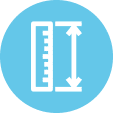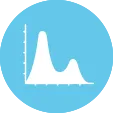Colour measurement of contact lenses and spectacle lenses
Contact lenses and glasses are not only used to correct eye conditions such as short-sightedness, long-sightedness, astigmatism and presbyopia, but are also a fashion accessory and part of a person’s personal image.
Plastic lenses are currently the most commonly used lenses, as they are relatively safe, inexpensive and easy to manufacture, as well as having outstanding optical quality.
HunterLab supports quality assurance throughout the entire manufacturing process: starting with the blanks, incoming QA tests of the liquid polymer components through to the end product lens or glass (but also spectacle frames and contact lens blister packaging). This also includes the film that serves as a polarizer for sunglasses and as an anti-reflective coating.
HunterLab spectrophotometers detect deviations and reduce the error rate of glasses and lenses, which are usually made of plastic. They determine optical clarity, enable colour tests with regard to tinting properties, as well as weathering and performance tests.
Our solutions for your products:
Vista
-
Colour & Haze
Simultaneous measurement of colour in transmission and haze. -
Enough space for samples
Large transmission shaft for many sizes and types of cuvettes, vials and foils. -
Integrated QC software
The EasyMatch QC Essentials quality control software is integrated into the device and provides all the required colour indices, colour numbers and metrics.
-
Full spectrum
Illumination range of 400-700 nm and long-life LED combination module -
Smart user interface
Your measurement results can be easily transferred to existing LIMS or SPC systems. -
Easy to use and precise
Simple "one touch" measurement reduces training time, optimizes the workflow and increases your productivity.
UltraScan VIS
-
Reflection
Measuring apertures with 25.4 mm and 9.35 mm provide the prerequisite for precise measurement results in reflection. -
Transmission
Large transmission compartment with 100 mm depth for measurements in total and regular transmission to determine color/opacity. -
Construction & function
The device complies with the internationally recognized colour measurement standards of ASTM, DIN and ISO.
-
10 nm resolution
With a true optical resolution of 10 nm, the UltraScan VIS offers high accuracy for measurements on liquids and solutions. -
CIE-recommended measuring range
The UltraScan VIS covers the wavelength range from 360 nm to 780 nm recommended by the CIE. -
Robust
Solid construction with optical bench and protected transmission range thanks to sliding cover.
Application example:
Color measurement of contact lenses with the Vista spectrophotometer from HunterLab In the development of contact lenses, whether made of glass or plastic, color measurement is used in several contexts [difl_advanced_blurb title="Color recognition" image="https://hunterlab.co.uk/wp-content/uploads/2024/03/HunterLab-Farbmessung-von-Kontaktlinsen-Einfaerbung-Blister-blog-2880w.jpg" image_icon_container_position="outside" image_placement="flex_right" image_icon_item_align="center" image_container_width="25%" content_width="100%" content_padding="|20px|||false|false" image_placement_tablet="flex_right" image_placement_phone="flex_top" image_placement_last_edited="on|phone"...
Further information for you on this topic:
-
Blog post "Colour measurement of contact lenses" Vista brochure
-
Vista brochure
-
UltraScan VIS brochure
HunterLab worldwide:
-
Europe / Middle East / Africa
HunterLab Europe GmbH
-
Dr.-August-Einsele-Ring 15
82418 Murnau
-
+49 8841 9464
Your local partner:
-
Headquarters, North / South America
Hunter Associates Laboratory, Inc.
-
11491 Sunset Hills Road
Reston, VA 20190-5280
-
+1 571 470 6028
-
Asia-Pacific
HunterLab Asia Limited -
Flat E, 13F Leahander Center,
28 Wang Wo Tsai Street,
Tsuen Wan,
New Territories,
Hong Kong -
+852 2406 1723
Ask us your question here...
Would you like to talk directly about your application/sample? Give us a call at
We will show you the colour measurement solution for your product.
Or simply fill out the form below.
Our colorimetry experts will be happy to help you!
The blog of HunterLab Europe
Everything to do with color measurement
Precise colour measurement of chemical powders In the chemical industry, colour is far more than a visual attribute – it is a crucial indicator of quality. Especially for powders, catalysts, and additives, even the slightest colour deviation can point to differences in purity, composition, or process conditions. Objective and repeatable colour measurement therefore provides valuable insights for quality assurance, product development, and process control. Why Colour Matters in Chemical Powders...
Define a coffee colour profile: The colour of coffee is much more than just an aesthetic feature....
The Vista from HunterLab offers the perfect solution for determining exact color values and the...

















